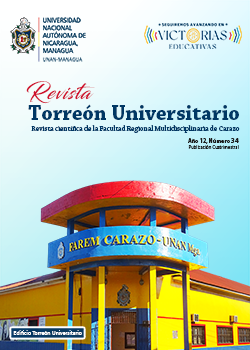Prototype of Experimental Practical Work on the Demonstration of the Existence of Miscible Fluids from Vector Calculus
DOI:
https://doi.org/10.5377/rtu.v12i34.16340Keywords:
Calculation, Evaluation, Fluids, Integrals, PrototypeAbstract
This article deals with the subject of experimental practical work prototypes for the demonstration of fluid mechanics equations when integrals and vector spaces are applied. The main objective was to demonstrate through a prototype the existence of miscible fluids from vector calculus. Likewise, theoretical concepts were analyzed in a sequential and logical way, through the investigation of integrals, vectors, fluid mechanics, prototypes and evaluation rubrics. A replica of a recreational swimming pool was built to demonstrate the application of miscible fluids in daily life, as well as the calculation of the force exerted by a fluid on a submerged plate by means of definite integrals. It is important to mention that an evaluation rubric was designed for the assessment of the work performed. The research was descriptive with a qualitative approach. In the results obtained, it was possible to demonstrate the existence of miscible fluids, in the same way, the equation indicated to calculate the force exerted by a fluid on a submerged plate was adapted, this through the interdisciplinarity between subjects of Calculus II, Algebra III, Structure of Matter and Educational Evaluation.
Downloads
References
Agüera Soriano, J. (2011). MECÁNICA DE FLUIDOS. En J. A. Soriano, DEFINICIONES Y PROPIEDADES
(págs. 13-14).
Ayala, M. (19 de enero de 2021). Paradigma interpretativo. Obtenido de Lifeder.com: https://www.lifeder.com/par
adigma-interpretativo-investigacion/
Bruto, M. (16 de septiembre de 2010). Conozca 3 tipos de investigación: descriptiva, exploratoria y explicativa.
Recuperado el 26 de abril de 2020, de Academia.edu: https://www.academia.edu/8101101/Conozca_3_tipos
_de_investigacion
Coelho, F. (1 de enero de 2019). Vector. Obtenido de https://www.significados.com/poesia/
Cuofano, G. (17 de agosto de 2022). FourWeekMBA. Obtenido de https://fourweekmba.com/es/prototipado/
De La Cruz Reyes, L. A. (30 de enero de 2019). Áreas: Aplicaciones de la integral (Matemáticas, física, ingeniería, etc.).
Recuperado el 20 de Octubre de 2022, de https://ingenieriaelectronica.org/areas-aplicaciones-de-la-integral-m
atematicas-fisica-ingenieria-etc/
Herrera Castrillo, C. J. (2022). Metodologías para el aprendizaje por competencias de Ecuaciones Diferenciales
aplicadas en Física al utilizar tecnología en la carrera Física Matemática. Revista Torreón Universitario, 11(32),33-44. Recuperado el 24 de Diciembre de 2022, de https://revistatorreonuniversitario.unan.edu.ni/index.php
/torreon/article/view/432/914
Iberti, C. (2000). Líquidos miscibles y no miscibles. ICARITO, Párr. 1-2.
LaMejorAsesoríaEducativa. (6 de septiembre de 2019). Aplicación de las integrales. Cálculo de fuerza en placas
sumergidas. [Video]. YouTube. Obtenido de https://www.youtube.com/watch?v=PQ0LxuG8bzg
Maranto Rivera, M., & González Fernández, M. E. (2015). Fuentes de Información. Universidad Autónoma del Estado
Hidalgo. Recuperado el 14 de Diciembre de 2022, de https://repository.uaeh.edu.mx/bitstream/bitstream/ha
ndle/123456789/16700/LECT132.pdf
Mata Solís, L. D. (7 de mayo de 2019). El enfoque de investigación. Investigaría, 1. Obtenido de https://investigaliac
r.com/investigacion/el-enfoque-de-investigacion-la-naturaleza-del-estudio/
Mott, R. L. (2006). Mecánica de Fluidos 6/e. Pearson educación. Recuperado el 03 de Octubre de 2022, de https://
acortar.link/librofluidos
Published
How to Cite
Issue
Section
License
Copyright (c) 2023 National Autonomous University of Nicaragua, Managua

This work is licensed under a Creative Commons Attribution-NonCommercial-NoDerivatives 4.0 International License.
The authors who publish in this journal agree to the following terms.
- The author or authors of the articles, essays or research grant the National Autonomous University of Nicaragua, Managua (UNAN-Managua) the editing rights (copyright) of the submitted work, therefore the University has the exclusive right to publish the article for the entire copyright period.
- These copyrights/authors authorize Torreón Universitario Magazine and the University to edit and disseminate/publish the article in said Magazine, including printed and electronic reproduction, storage, retrieval and any other type of publication, and sources of secondary information as services. of summaries and databases, they also empower it to protect the article against unauthorized use for dissemination by printed or electronic media (PDF, HTML, EPUB, XML or others).
License for use of content
The magazine uses the Creative Commons Attribution-NonCommercial-NoDerivs 4.0 International License.
Under this statement:

This journal is licensed under a Creative Commons Attribution-NonCommercial-NoDerivatives 4.0 International License. It can be copied, distributed and transmitted publicly as long as the author and source are cited (Revista Torreón Universitario), it should not be modified or used for any commercial purpose. The full license can be found at http://creativecommons.org/licenses/by-nc-nd/4.0/.



